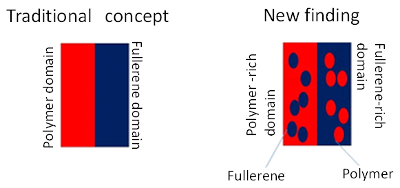The interface state as conventionally understood (left) and the interface structure in which we observed intermixed molecules in this study (right)
Using a soft X-ray microscope, a Japanese research team has examined the nanostructure of organic solar cells and discovered that different molecules are intermixed in each molecular domain.
This discovery is expected to reveal the energy conversion mechanism in organic solar cells and thereby facilitate the establishment of guidelines to design high efficiency organic solar cells.
Bulk heterojunction organic solar cells are characterized by their high energy conversion efficiency. In order to improve the efficiency of cells, it had been thought to be important up until now to have a clean interface between a polymer material and a single molecular domain of a fullerene. However, when the researchers carefully examined the domain structure of cell materials that were optimized for energy conversion efficiency using a new methodology involving a soft X-ray microscope, they found that different molecules were intermixed in each molecular domain. In other words, they found that cells with a "dirty" interface have superior performance to those with a "clean" interface. This new discovery defies the common understanding of the energy conversion mechanism.
These results were published on April 16, 2014 in the online version of Applied Physics Express, a journal issued by the Japan Society of Applied Physics.
Provided by National Institute for Materials Science























